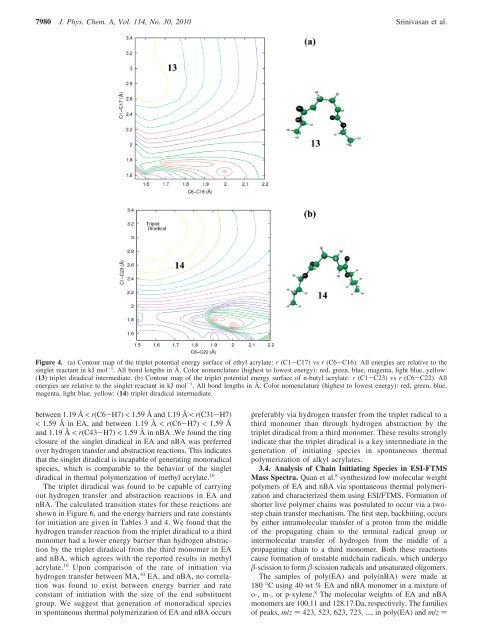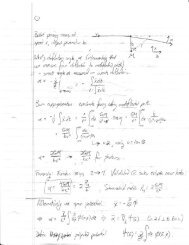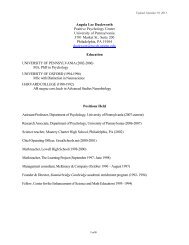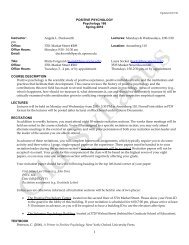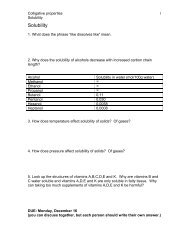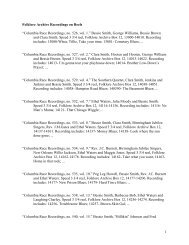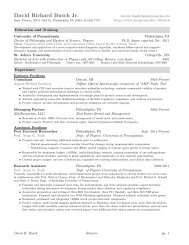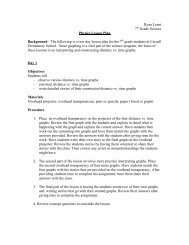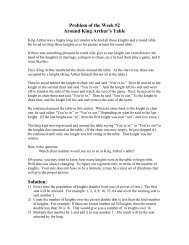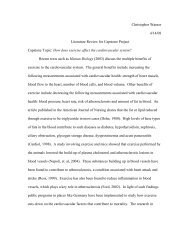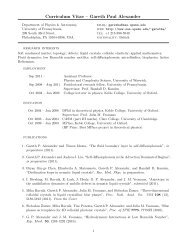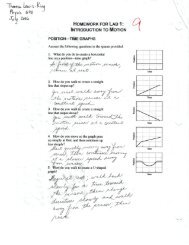Self-Initiation Mechanism in Spontaneous Thermal Polymerization of ...
Self-Initiation Mechanism in Spontaneous Thermal Polymerization of ...
Self-Initiation Mechanism in Spontaneous Thermal Polymerization of ...
Create successful ePaper yourself
Turn your PDF publications into a flip-book with our unique Google optimized e-Paper software.
7980 J. Phys. Chem. A, Vol. 114, No. 30, 2010 Sr<strong>in</strong>ivasan et al.<br />
Figure 4. (a) Contour map <strong>of</strong> the triplet potential energy surface <strong>of</strong> ethyl acrylate: r (C1-C17) vs r (C6-C16). All energies are relative to the<br />
s<strong>in</strong>glet reactant <strong>in</strong> kJ mol -1 . All bond lengths <strong>in</strong> Å. Color nomenclature (highest to lowest energy): red, green, blue, magenta, light blue, yellow:<br />
(13) triplet diradical <strong>in</strong>termediate. (b) Contour map <strong>of</strong> the triplet potential energy surface <strong>of</strong> n-butyl acrylate: r (C1-C23) vs r (C6-C22). All<br />
energies are relative to the s<strong>in</strong>glet reactant <strong>in</strong> kJ mol -1 . All bond lengths <strong>in</strong> Å. Color nomenclature (highest to lowest energy): red, green, blue,<br />
magenta, light blue, yellow: (14) triplet diradical <strong>in</strong>termediate.<br />
between 1.19 Å < r(C6-H7) < 1.59 Å and 1.19 Å < r(C31-H7)<br />
< 1.59 Å <strong>in</strong> EA, and between 1.19 Å < r(C6-H7) < 1.59 Å<br />
and 1.19 Å < r(C43-H7) < 1.59 Å <strong>in</strong> nBA .We found the r<strong>in</strong>g<br />
closure <strong>of</strong> the s<strong>in</strong>glet diradical <strong>in</strong> EA and nBA was preferred<br />
over hydrogen transfer and abstraction reactions. This <strong>in</strong>dicates<br />
that the s<strong>in</strong>glet diradical is <strong>in</strong>capable <strong>of</strong> generat<strong>in</strong>g monoradical<br />
species, which is comparable to the behavior <strong>of</strong> the s<strong>in</strong>glet<br />
diradical <strong>in</strong> thermal polymerization <strong>of</strong> methyl acrylate. 10<br />
The triplet diradical was found to be capable <strong>of</strong> carry<strong>in</strong>g<br />
out hydrogen transfer and abstraction reactions <strong>in</strong> EA and<br />
nBA. The calculated transition states for these reactions are<br />
shown <strong>in</strong> Figure 6, and the energy barriers and rate constants<br />
for <strong>in</strong>itiation are given <strong>in</strong> Tables 3 and 4. We found that the<br />
hydrogen transfer reaction from the triplet diradical to a third<br />
monomer had a lower energy barrier than hydrogen abstraction<br />
by the triplet diradical from the third monomer <strong>in</strong> EA<br />
and nBA, which agrees with the reported results <strong>in</strong> methyl<br />
acrylate. 10 Upon comparison <strong>of</strong> the rate <strong>of</strong> <strong>in</strong>itiation via<br />
hydrogen transfer between MA, 10 EA, and nBA, no correlation<br />
was found to exist between energy barrier and rate<br />
constant <strong>of</strong> <strong>in</strong>itiation with the size <strong>of</strong> the end substituent<br />
group. We suggest that generation <strong>of</strong> monoradical species<br />
<strong>in</strong> spontaneous thermal polymerization <strong>of</strong> EA and nBA occurs<br />
preferably via hydrogen transfer from the triplet radical to a<br />
third monomer than through hydrogen abstraction by the<br />
triplet diradical from a third monomer. These results strongly<br />
<strong>in</strong>dicate that the triplet diradical is a key <strong>in</strong>termediate <strong>in</strong> the<br />
generation <strong>of</strong> <strong>in</strong>itiat<strong>in</strong>g species <strong>in</strong> spontaneous thermal<br />
polymerization <strong>of</strong> alkyl acrylates.<br />
3.4. Analysis <strong>of</strong> Cha<strong>in</strong> Initiat<strong>in</strong>g Species <strong>in</strong> ESI-FTMS<br />
Mass Spectra. Quan et al. 8 synthesized low molecular weight<br />
polymers <strong>of</strong> EA and nBA via spontaneous thermal polymerization<br />
and characterized them us<strong>in</strong>g ESI/FTMS. Formation <strong>of</strong><br />
shorter live polymer cha<strong>in</strong>s was postulated to occur via a twostep<br />
cha<strong>in</strong> transfer mechanism. The first step, backbit<strong>in</strong>g, occurs<br />
by either <strong>in</strong>tramolecular transfer <strong>of</strong> a proton from the middle<br />
<strong>of</strong> the propagat<strong>in</strong>g cha<strong>in</strong> to the term<strong>in</strong>al radical group or<br />
<strong>in</strong>termolecular transfer <strong>of</strong> hydrogen from the middle <strong>of</strong> a<br />
propagat<strong>in</strong>g cha<strong>in</strong> to a third monomer. Both these reactions<br />
cause formation <strong>of</strong> unstable midcha<strong>in</strong> radicals, which undergo<br />
β-scission to form β-scission radicals and unsaturated oligomers.<br />
The samples <strong>of</strong> poly(EA) and poly(nBA) were made at<br />
180 °C us<strong>in</strong>g 40 wt % EA and nBA monomer <strong>in</strong> a mixture <strong>of</strong><br />
o-, m-, or p-xylene. 8 The molecular weights <strong>of</strong> EA and nBA<br />
monomers are 100.11 and 128.17 Da, respectively. The families<br />
<strong>of</strong> peaks, m/z ) 423, 523, 623, 723, ..., <strong>in</strong> poly(EA) and m/z )


